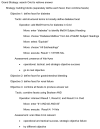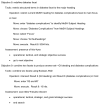A multi-level model of information seeking in the clinical domain
- PMID: 18006383
- PMCID: PMC2384229
- DOI: 10.1016/j.jbi.2007.09.005
A multi-level model of information seeking in the clinical domain
Abstract
Objective: Clinicians often have difficulty translating information needs into effective search strategies to find appropriate answers. Information retrieval systems employing an intelligent search agent that generates adaptive search strategies based on human search expertise could be helpful in meeting clinician information needs. A prerequisite for creating such systems is an information seeking model that facilitates the representation of human search expertise. The purpose of developing such a model is to provide guidance to information seeking system development and to shape an empirical research program.
Design: The information seeking process was modeled as a complex problem-solving activity. After considering how similarly complex activities had been modeled in other domains, we determined that modeling context-initiated information seeking across multiple problem spaces allows the abstraction of search knowledge into functionally consistent layers. The knowledge layers were identified in the information science literature and validated through our observations of searches performed by health science librarians.
Results: A hierarchical multi-level model of context-initiated information seeking is proposed. Each level represents (1) a problem space that is traversed during the online search process, and (2) a distinct layer of knowledge that is required to execute a successful search. Grand strategy determines what information resources will be searched, for what purpose, and in what order. The strategy level represents an overall approach for searching a single resource. Tactics are individual moves made to further a strategy. Operations are mappings of abstract intentions to information resource-specific concrete input. Assessment is the basis of interaction within the strategic hierarchy, influencing the direction of the search.
Conclusion: The described multi-level model provides a framework for future research and the foundation for development of an automated information retrieval system that uses an intelligent search agent to bridge clinician information needs and human search expertise.
Figures




Similar articles
-
Understanding the information needs of public health practitioners: a literature review to inform design of an interactive digital knowledge management system.J Biomed Inform. 2007 Aug;40(4):410-21. doi: 10.1016/j.jbi.2006.12.008. Epub 2007 Jan 11. J Biomed Inform. 2007. PMID: 17324632 Review.
-
The BioPrompt-box: an ontology-based clustering tool for searching in biological databases.BMC Bioinformatics. 2007 Mar 8;8 Suppl 1(Suppl 1):S8. doi: 10.1186/1471-2105-8-S1-S8. BMC Bioinformatics. 2007. PMID: 17430575 Free PMC article.
-
Nursing constraint models for electronic health records: a vision for domain knowledge governance.Int J Med Inform. 2005 Dec;74(11-12):886-98. doi: 10.1016/j.ijmedinf.2005.07.013. Epub 2005 Aug 22. Int J Med Inform. 2005. PMID: 16115795
-
Infobuttons and classification models: a method for the automatic selection of on-line information resources to fulfill clinicians' information needs.J Biomed Inform. 2008 Aug;41(4):655-66. doi: 10.1016/j.jbi.2007.11.007. Epub 2007 Dec 8. J Biomed Inform. 2008. PMID: 18249041 Free PMC article.
-
Managing complex augmented reality models.IEEE Comput Graph Appl. 2007 Jul-Aug;27(4):48-57. doi: 10.1109/mcg.2007.85. IEEE Comput Graph Appl. 2007. PMID: 17713234 Review. No abstract available.
Cited by
-
Information-seeking behavior of medical residents in clinical practice in Bahia, Brazil.J Med Libr Assoc. 2008 Oct;96(4):381-4. doi: 10.3163/1536-5050.96.4.016. J Med Libr Assoc. 2008. PMID: 18974818 Free PMC article. No abstract available.
-
Facilitating biomedical researchers' interrogation of electronic health record data: Ideas from outside of biomedical informatics.J Biomed Inform. 2016 Apr;60:376-84. doi: 10.1016/j.jbi.2016.03.004. Epub 2016 Mar 10. J Biomed Inform. 2016. PMID: 26972838 Free PMC article. Review.
-
Comprehensive process model of clinical information interaction in primary care: results of a "best-fit" framework synthesis.J Am Med Inform Assoc. 2018 Jun 1;25(6):746-758. doi: 10.1093/jamia/ocx085. J Am Med Inform Assoc. 2018. PMID: 29025114 Free PMC article.
-
Modeling knowledge resource selection in expert librarian search.Stud Health Technol Inform. 2009;143:36-41. Stud Health Technol Inform. 2009. PMID: 19380912 Free PMC article.
-
Exploring patient information needs in type 2 diabetes: A cross sectional study of questions.PLoS One. 2018 Nov 16;13(11):e0203429. doi: 10.1371/journal.pone.0203429. eCollection 2018. PLoS One. 2018. PMID: 30444868 Free PMC article.
References
-
- Covell DG, Uman GC, Manning PR. Information needs in office practice: are they being met? Ann Intern Med. 1985 Oct;103(4):596–9. - PubMed
-
- D'Alessandro DM, Kreiter CD, Peterson MW. An evaluation of information-seeking behaviors of general pediatricians. Pediatrics. 2004;113(1):64–9. - PubMed
-
- Green ML, Ciampi MA, Ellis PJ. Residents' medical information needs in clinic: Are they being met? Am J Med. 2000;109(3):218–23. - PubMed
Publication types
MeSH terms
Grants and funding
LinkOut - more resources
Full Text Sources

